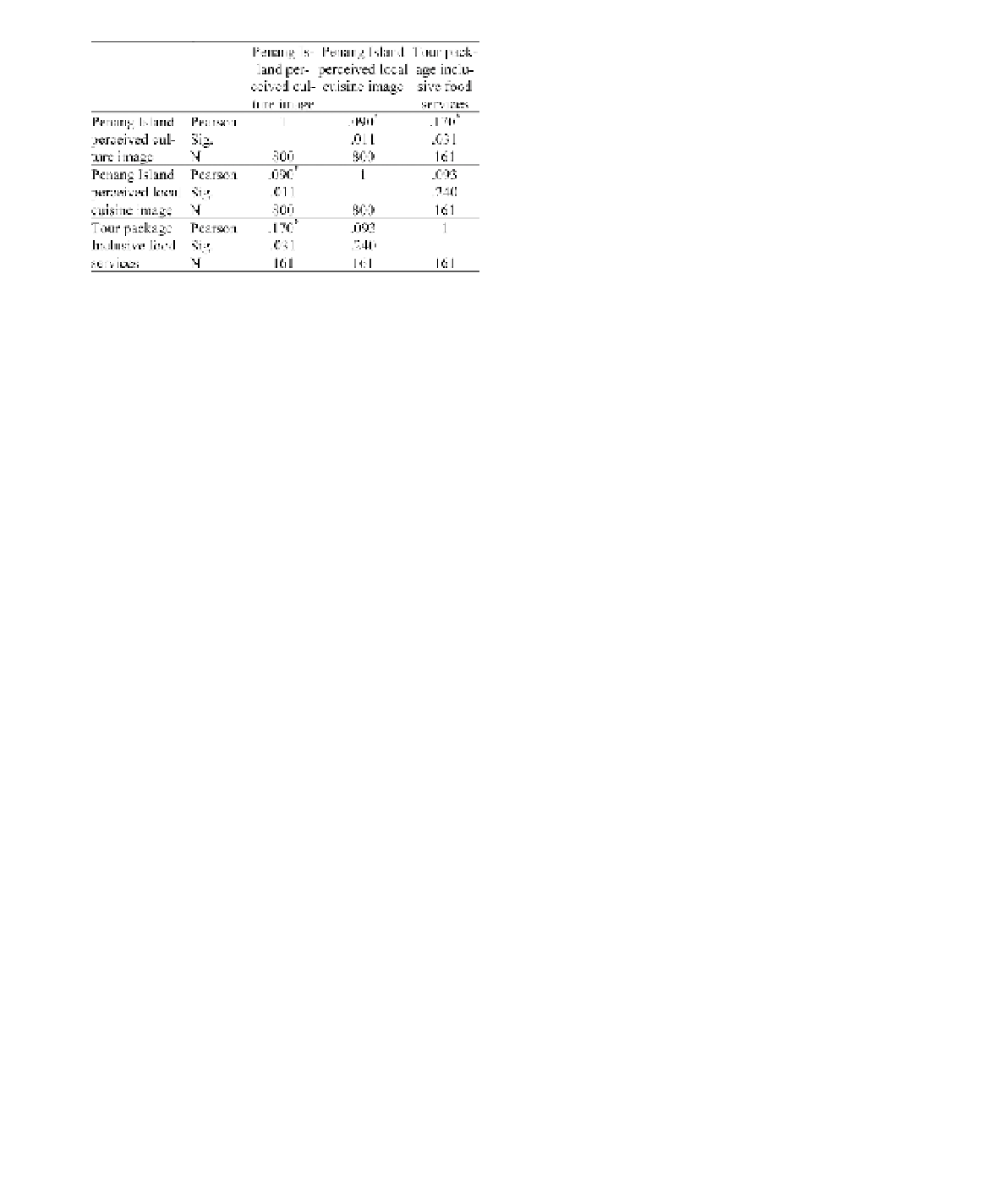Travel Reference
In-Depth Information
Table 2. The Penang Island images and tour package
(food services) relationship.
Penangites (and the other visitors) are artful and
a pampered lot when it comes to food; limited
number of respondents (56) placed priority and
preference towards tour package that include food
services. This finding translated into the inability
of food construct serving as a travel motivation to
the Penang Island. This is further strengthened by
the fact that the well-famed Penang Island dishes
(Ab Karim, K'ng, Othman, Ghazali & Abd. Halim
2012) could only offer a low degree impact as cul-
tural landscape. In other words, the connection
between the Penang Island and food tourism is yet
to be recognized by the international tourists. In
light of this situation, the Malaysian Exhibition
Services Sdn Bhd (2014) is upholding the connec-
tion by organizing a conference on food, hotel and
tourism that will be held in November 2014; in
conjunction with promoting Penang as a place that
offer the state-of-the-art business platform.
Within this paper knowledge, results in relation
to 'preferences of items bought' variable is strongly
described by the Tourism Malaysia's (2012) docu-
mentation on the Penang Island's famous dishes
preferred. Here, it is clearly shown that dishes that
are most enjoyed by visitors (for example Penang
Laksa, Char Kuey Teow, Hokkien Mee and Nasi
Kandar) exclusively come in the form of dine-in
and/or takeaway, with limited life cycle and is
unsuitable for air and/or long travel. Logically, the
food products that are suitable for air travel (which
also can serve as souvenirs purpose) should have
a lower reaction to chemical and climate change
(Natural Resources Defense Council, 2007). The
food may come in the form of crackers, granola
bar nibbles, cookies and muffins. Therefore, this
finding shall play a major role in directing the
food-based business players in improving and
upgrading their products' quality. Simply stated,
the products, more importantly, should meet the
following requirement, but not limited to: long life
cycle, ability to be repacked, easily transported con-
venient size and considered as a whole meal on its
own. Other than bringing the famous dishes into
the international market by means of powdered
base/stock, attention can be allocated towards the
Malaysia's dried dessert for example bahulu, sagun
and maruku.
On the other hand, despite the positive rela-
tionships documented by the culture construct,
variables exhibited a notably low dependency level
(below 25 percent) except for the Penang Island
perceived cultural image and cultural distinctive-
ness relationship (100 percent dependency level).
The findings are resulted from the existence of
multicultural society where parts of this society
are living within the historical sites area and still
conserving (directly and/or indirectly) the cul-
ture settings as documented by Lim (2011). More
'preferences of items bought' variable (a decrease
contributes to an increase of 2.457 units for the
relationship). Within this paper's interest, this
could be translated into offering food-based tour-
ism products that have a long life cycle as well as
easy to be transported.
In correspondence analysis, this paper searches
for the dependency level between each construct's
variables and between constructs. Each construct
reveals significant relationship except for the Pen-
ang Island perceived local cuisine image and tour
package inclusive food services (0.237) and the
Penang Island perceived cultural image and histor-
ical uniqueness (0.286). Despite the similar signifi-
cant value (.000), only one relationship presents a
total dependency (the Penang Island perceived cul-
tural image and cultural distinctiveness), while the
remaining dependency levels amounted below than
25 percent (except for the Penang Island perceived
local cuisine image and chances to experience local
cuisine
70 percent). Additionally, results have
brought attention to relationships present by the
Penang Island perceived images and tour package
inclusive food services variables. Despite the lower
significant level (.031) compared to the Penang
Island perceived local cuisine images (.011), the
Penang Island perceived cultural image is observed
to be more dependent on tour package inclusive
food services variable (29 percent) (as supported
by the correlation analysis, significant at .05) (see
Table 2).
=
4
DISCUSSIONS AND CONCLUSIONS
Based on the above mentioned findings, it is
learned that little impact on travelling to/visiting
the Penang Island propensity has been contributed
by the food construct. Although 'Penang food
tourism' keyword shows as a highly research con-
tent via means of the Internet (77.6 million results)
and according to Tourism Malaysia (2012), the




Search WWH ::

Custom Search